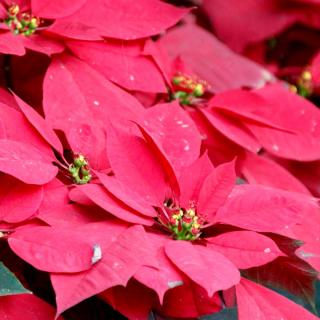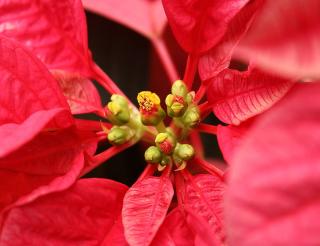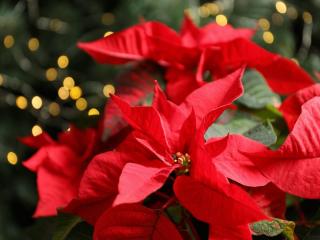

Poinsettia gets all the votes at Christmas, since red and green match the colors of the party! After the season is over, one question remains: how can you get it to turn red?
Poinsettia, or “Christmas star”, invades garden stores from now until the end of the year. Its appeal lies in the famous colored bracts that surround its tiny flowers.
The challenge? Make your poinsettia turn red again year after year!
 Colored leaves appear during days with short daylight hours. This means it needs less sunlight and more darkness.
Colored leaves appear during days with short daylight hours. This means it needs less sunlight and more darkness.
It takes 2 months for these new red leaves to form, so plan ahead:
1/ Start the poinsettia’s “sunlight diet” in September (mid or end).
2/ Keep rationing light through October and November.
3/ It’ll get red leaves around Christmas and New Years.
For maximum color on new leaves, make sure your poinsettia gets 14 to 15 hours of complete darkness every day.
Stick to the routine day in and day out, ideally always at the same time of day. You’re imitating the continuous, long winter nights from its native Mexico wilderness.
Practically, you’ve got two ways to get this done:
 During this “light diet”, try to keep cooler temperatures during the nighttime, around 60 to 65°F (15 to 18°C). Water normally: this is still a growth phase for the plant. It isn’t yet dormant and needs regular watering.
During this “light diet”, try to keep cooler temperatures during the nighttime, around 60 to 65°F (15 to 18°C). Water normally: this is still a growth phase for the plant. It isn’t yet dormant and needs regular watering.
Once the eight weeks are over, no need to control its light intake anymore. And it will flower again – most certainly! – at Christmas.
Poinsettia grows in the wild in Mexico where it easily reaches six feet (two meters) tall. In temperate climates, it grows much smaller, making it ideal for decorating tables.
→ Red is most common, but some are pink, salmon orange, yellow,cream,white,mottled… They all have bright green leaves as a backdrop.
Too often, poinsettia has a sad fate once the party is over… and ends up in the trash (or, slightly better, the compost pile…)!
 After the blooming, simply place it in a cool room and give it water at regular intervals. At the end of spring, reduce watering. When leaves start falling off, the plant is entering its dormant phase. As this occurs, let the soil dry up completely for a month. At the end of this phase, cut it back quite short, back to 4 inches (10 cm), and water to trigger a new vegetation phase. Place it in a warm spot.
After the blooming, simply place it in a cool room and give it water at regular intervals. At the end of spring, reduce watering. When leaves start falling off, the plant is entering its dormant phase. As this occurs, let the soil dry up completely for a month. At the end of this phase, cut it back quite short, back to 4 inches (10 cm), and water to trigger a new vegetation phase. Place it in a warm spot.
Poinsettia appreciates surrounding temperature between 60 and 74°F (15 and 23°C) while avoiding hot, dry air and drafts. Proper moisture must be ensured (immerse the pot in water at room temperature, then drip excess water out without ever letting water accumulate in the saucer). Also give it a lot of light. You can bring the plant outdoors between May and September and feed it fertilizer over the summer.
→ Gardening: poinsettia care
My poinsettia bought last November is still perky and the red blooms getting bigger as the tiny green
buds turn into red leaves in the middle of the bloom. We live in a cool NW climate. I would like to
repot and put it outside during the summer. Will that work? I’ve never had a poinsettia last this
long (5 mos). It is in a corner where light comes in from both east and south so it has light for most
of the day. The living room is kept at about 70 degrees. It is still cool outside.
It certainly seems to love the attention and care you give it!
I think it’ll be quite happy outdoors for a spell. I’d suggest repotting nowadays and then waiting 3-4 weeks before bringing it out. This would reduce the shock to the plant: interfering with both roots and exposure at the same time is delicate.
Repotting shouldn’t be a problem, but when you move it outdoors, do it progressively: 2 or 3 hours for 3-4 days, then 5-6 hours for 3-4 more, and then finally full-time outdoors. This will let the plant “get used to it”. And you’ll also have time to observe the plant and see whether it’s really happy with the change or whether it’s starting to suffer (drooping leaves…).
Hello,
The Poinsettias are at work and no one is there over the weekend. Should I leave them in the dark room over the weekend (am trying to get red leaves for Xmas)
Thank you!
Hi Liz! Yes, that’s actually a better option than to let them think days are suddenly getting longer again.
My four poinsettia l bought this past mid Dec still has all the pinky red leaves on it today April 11. I had planted it in full sun here in central Fl, but dug them up March1 to transplant to north side of house where they are loving it. I was shocked that they still look beautiful.
That’s really a testimony to how well you’ve been treating them! Congratulations! In tropical countries they can even grow to shrubby heights, too.
What should I do with my poinsettia after Christmas?
Hi Leanne! Well, actually, there are a few steps you can do:
Place your poinsettia in a cool room.
– Water regularly but only a small amount, like a half-glass every couple weeks, until Spring.
– at the end of Spring, stop watering. This will lead to old leaves falling off. Keep the soil dry for a full month.
– Cut the stems back to 4 inches (about 10 cm), and start watering again and place in a warmer spot.
Living in South Africa with winter months May to September/October when should I start the “cupboard treatment”?
In the Southern Hemisphere, you’d start the “cupboard treatment” in March instead of September, with the goal of triggering red leaves end of May. That way, you’re tricking the plant into thinking winter is over right when it’s in full swing! Nice way to have color around when most other plants are dormant.
Thank you Gaspard! This info was really helpful.
I´m actually living in a tropical island and there is a lot of sun and sometimes rain but no snow or cold weather that´s why i was asking about the sun light. The stems on the plant are already reddish but the leaves are still green. Any other advice with regards to watering, like would the rain wetting be good for it and when would be the best time for watering?
Really appreciate all the advice you are giving.
Regards,
Clyne
Since cold temperatures aren’t a problem, it’s perfectly possible to let it get rainwater, it’s the best possible water for potted plants. As long as the pot drains well (it must absolutely have a hole at the bottom), there won’t be any issues. You’re very welcome!
If i just started putting my poinsettia plant in the dark, just the ending of November, would it still turn red?
What’s for certain is that it will in every case still turn redder than if you hadn’t begun doing so! It might not be a complete flush of red, but it will nicely mix reddish center with green crowns, which is also pretty Christmas-y, too.
Thanks you Gaspard!
That brings me to my next 2 questions.
1. Is the night the best time to put it in a dark room for 12-14 hours?
2. Do i need to take it out of the dark room and put it outside to get fresh air and natural sunlight but not direct?
Sure thing!
1. Yes of course night is better. Say 6 pm to 8 am or 5pm to 7am. You’re not blocking out light entirely, just pretending winter days are already at their shortest. That way, when you bring out for “longer” days in a warmer room, the plant thinks it’s Spring.
2. Yes, to give it light. Keep it cool but not freezing cold. If you’re in the northern hemisphere, a north-facing window in an unheated room such as a garage is perfect, but outside is also fine as long as it doesn’t freeze.